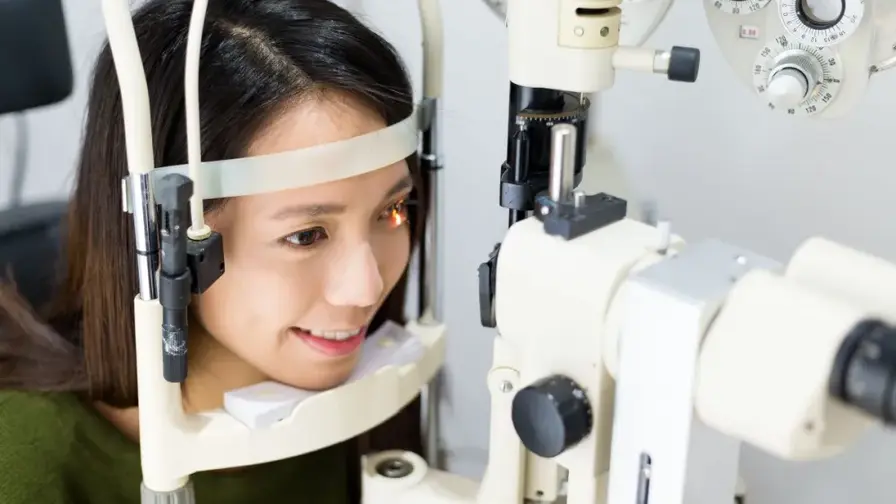If the structure of eye area 1 is too thin, don't use laser! Doctors reveal that "this situation" is the most unpleasant to see: even wearing glasses is difficult to save

Laser technology for myopia is advancing rapidly, but the thickness of the “corneal stromal layer” in the eye is not enough, so there are certain risks in undergoing surgery? Dr. Chen Meijing, a full-time physician at Taipei Renai Hospital of Weishi Ophthalmology, said in an interview that the stability of the corneal structure is significantly related to whether it is suitable for myopia laser; the corneal stromal layer that can be preserved by different surgical methods also varies.
Not everyone can do myopia laser? If the “1 structure” of the eye is too thin, it may be shot by the doctor
“The structure of the human cornea can be divided into five layers, namely epithelial layer, Descemet’s membrane, stromal layer, Descemet’s membrane, and endothelial layer. The stromal layer is the main component of the cornea!” Dr. Chen Meijing explained that the stromal layer is The thickest structure of the cornea, accounting for approximately 90% of the cornea’s thickness, is composed of collagen fibers and water, providing the corneal structure with transparency and strength.
Myopia laser surgery mainly corrects myopia or astigmatism by reshaping the shape of the cornea to change the way light enters the eye so that the light can accurately focus on the retina. Dr. Chen Meijing pointed out that the health of the cornea is closely related to the feasibility of surgery; if the cornea is naturally too thin, the risk of postoperative complications may increase after surgery. Therefore, detailed corneal examination before surgery and preservation of more stromal layer during surgery are crucial to promote postoperative eye health.
“The most unwelcome situation for ophthalmologists” Remaining cornea that is too thin may cause “keratoconus”
If the remaining cornea is found to be too thin after myopia laser surgery, what are the possible sequelae? Dr. Chen Meijing explained that if the cornea is cut too thin, it will easily soften and become unable to withstand the normal pressure in the eye. It may cause convex lesions and abnormal astigmatism, and gradually turn into “keratoconus”. “This is the most important thing for ophthalmologists.” An unpleasant situation!"
Dr. Chen Meijing explained that the cornea can be imagined as the surface of a balloon. If its texture is uniform and of good quality, the surface can withstand the internal pressure normally when the balloon is inflated. However, if the balloon surface is of varying thicknesses or even softens, the surface will appear uneven. The condition is called keratoconus. At this time, the patient’s vision will be seriously affected, and it will be difficult to obtain clear vision even if he wears glasses.
Head-to-head confrontation between 3 major myopia lasers! “It” retains the thickness after surgery to the extreme end
Since preserving the stromal layer is so important, among the three current mainstream myopia laser surgeries, which one is likely to consume more of the corneal stromal layer? Dr. Chen Meijing pointed out that assuming the treatment optical zone and correction power are the same, “Smile Pro” consumes the most thickness of the corneal stromal layer, while “LASIK” and “SMART TransPRK” procedures are almost the same.
If the depth of the wound during the operation is used as a distinction, “surface surgery” SMART TransPRK surgery does not require the creation of a corneal flap, but uses laser to reshape the corneal stromal layer from the top of the cornea to reduce the impact on the inner structure of the cornea; “deep surgery” Surgery" Smile Pro is a minimally invasive surgery that uses laser to cut a small lens in the inner layer of the cornea, and removes the lens through a small incision of about 2-4 mm to correct vision.
Dr. Chen Meijing emphasized that although the thickness of the stromal layer that can be reserved after LASIK, which is also a deep surgery, is not much different from that of SMART TransPRK, the stability of the eye structure after surgery is relatively low because of the need to create a corneal flap. SMART TransPRK still has the opportunity to preserve the maximum remaining thickness of the posterior cornea, and is expected to reduce the risk of postoperative complications caused by too thin a cornea.
How much corneal thickness should be reserved for myopia laser? Doctors reveal the ideal value
Dr. Chen Meijing emphasized that everyone’s innate corneal thickness is different, so during preoperative evaluation, the “residual corneal thickness” will be used as the basis for whether it is suitable for myopia laser surgery; factors that affect corneal thickness include native corneal thickness, Myopia or astigmatism, pupil size, etc. Taking LASIK as an example, the remaining thickness of the posterior cornea after surgery is approximately 250㎛.
As for superficial surgery, SMART TransPRK has the characteristics of “zero contact, no flap lifting” and can preserve the corneal stromal layer to the greatest extent. However, factors such as corneal curvature and dry eye condition still need to be considered before myopia laser surgery, and multiple examinations must be taken to ensure that the maximum corneal stromal layer is preserved. After the epithelial layer is regenerated after surgery, the corneal structure will be complete and stable, and the visual quality and long-term stability of the cornea will be better.
“If you are worried about insufficient preservation of the corneal stromal layer, it is recommended to give priority to an ophthalmology hospital that uses the high specification “350㎛” as the standard for surgery. With SMART TransPRK surgery, it is expected to preserve the most corneal stromal layer! We also remind the public that corneal resection is Being too thin will greatly reduce the chance of second surgery, just like buying a one-way ticket and hitting the road, there is no turning back!”
What to do with the “residual degree” after myopia laser treatment? Can I have a second surgery if I am not satisfied?
Dr. Chen Meijing reminded that since the wound is located on the surface of the superficial surgery, it is recommended to rest for more than 3 days and follow the doctor’s instructions to apply eye drops on time to wait for the regeneration of the epithelial layer. During the wound recovery process, conditions such as dry eyes and nighttime glare may occur depending on individual conditions. As the wound recovers, vision will gradually and stably return to optimal vision. However, everyone’s recovery status is different, and it is recommended to keep it under observation for 3-6 months.
If it is found that there is residual power after surgery, SMART TransPRK can retain more remaining thickness, so there is an opportunity to undergo a second surgery after the vision recovers. A small number of patients will encounter the problem that the best corrected visual acuity is not as good as expected after surgery. Dr. Chen Meijing explained that the corneal structure is instantly changed, and the brain is still adapting to the new field of view. It is recommended to stay more time for observation and follow up regularly.
“Finally, I would like to remind people who want to undergo myopia laser surgery that myopia laser surgery is a selective surgery. Those with insufficient thickness and poor shape of the cornea are not suitable for surgery. If you insist on having surgery, the risk of keratoconus will increase!” Dr. Chen Meijing appeals to the public to complete relevant eye examinations before surgery so as to ensure clear and healthy vision after surgery.
Further reading:





